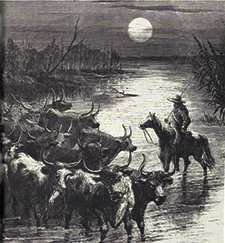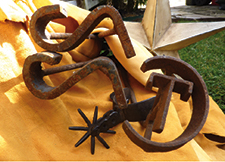
Texas cowboys guiding a herd of longhorn steers across a stream during a trail drive In the 1860s. Image from The Texans by David Nevin.
A LITTLE PIECE OF HISTORY | By Joan Frances –
When the early settlers of Fort Bend County began prospering in the area, growing cotton and raising cattle was a top priority. Unlike premium priced cotton acreage, grazing land was relatively inexpensive. As cities grew and ranches emerged, the foundation of the cattle empire became a profitable investment. After assembling land and animals, cattlemen had minimal expenses. They had to look after the herds so they did not stray and brand them to permanently identify the owner.
The basic stock for Fort Bend commercial herds was longhorn cattle. The Mexican ranchers introduced this type of cattle long before the settlers arrived. In the early days, the animals roamed freely and belonged to any rancher who roped and branded them. To improve the longhorns, several cattlemen imported pure blooded bulls and bred them to choice native cows. As ranches and the cattle population increased, branding became necessary in order to identify ownership and discourage theft.
Branding can be traced back 4,000 years to the Egyptian tomb paintings. When the Spanish brought cattle to the area, before fencing, branding became a part of Fort Bend County’s history. Registered brands in the mid 1700s were required as cattle raising spread. The early brands were pictographic in nature, and many featured curlicues or pendants. They became more ornate. As each Spanish colonist’s son acquired his own cattle, he added something artistic to his father’s design. The Texas ranchers had a difficult time interpreting the Spanish brands and often referred to them as “dog irons” or “quien sabes,” which means, “Who knows?”

These brands are used to identify ownership
of cattle through symbols and letters.
American cowboys designed cattle brands in a much simpler format. They usually sported initials, numbers or even names that identified the owner or his ranch. Sometimes, common objects were used as brands, such as an anvil, door key, spur, boot, hat, frying pan or pitchfork. No law dictated exactly where the branding should be placed, yet the left side of the animal seemed to be the customary spot. Ranchers also cut marks and slits on the cartilage of the ear of the cow to identify them. Fort Bend County registered brands and earmarks in 1838. In 1848, following independence from Mexico, the Republic of Texas required ranchers to register their cattle brands and created a law that cattle theft could be prosecuted only if stolen cattle bore a registered brand.

Made to last a lifetime, ranch brands are comprised of cast iron and differing lengths.
In 1877, C. C. Slaughter and 40 cattlemen founded Texas and Southwestern Cattle Raisers Association (TSCRA) in Graham, Texas. Their mission was to “protect the stewards of land and livestock in the Southwest.” In 1893, a vigilant group of peace officers set out to fight cattle theft in the region. Through its special rangers, TSCRA became a respected organization worldwide. The brand inspection program and database was attributed to apprehending countless cattle thieves.
Today, special market inspectors in Fort Bend County record a complete description of every cow including color, sex, age, class, earmarks and brands. All of the information is entered into the association’s database. Through its highly efficient and detailed database, TSCRA maintains a record of more than 100,000 brands in Texas. Beginning August 30, 1981, Fort Bend County required all cattle to have distinctive earmarks and brands recorded with the clerk where the livestock is located per the Texas Agriculture Code. Records and a copy are mailed to the Texas State Cattle Association. Fort Bend County takes great pride in keeping this history alive and successfully working. Branding will continue to be an effective way to identify cattle ownership and is a testament to the ingenuity of Fort Bend’s ancestors.